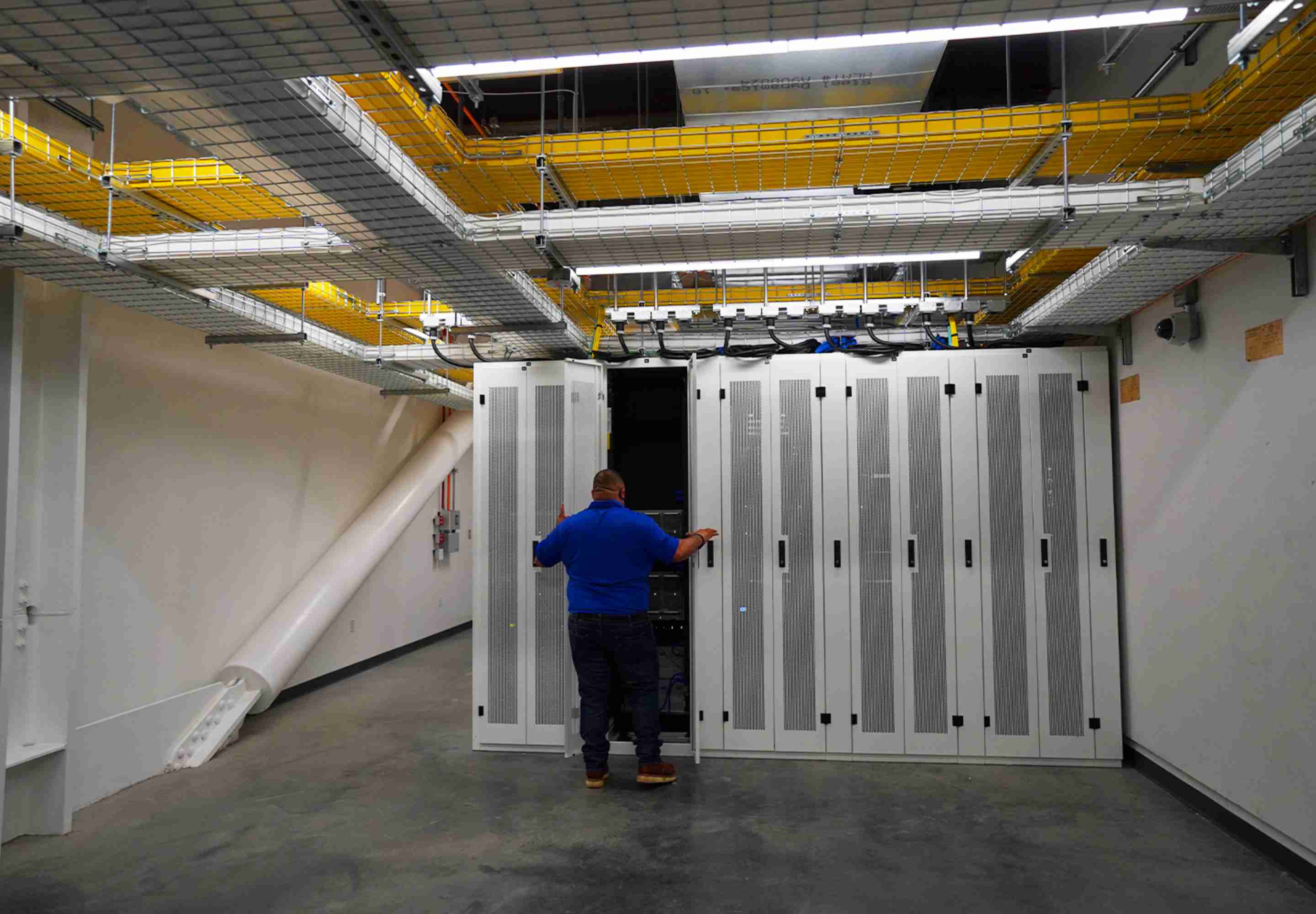-
Featured services
2026 Global AI Report: A Playbook for AI Leaders
Why AI strategy is your business strategy: The acceleration toward an AI-native state. Explore executive insights from AI leaders.
Access the playbook -
Services
Alle Services und Produkte anzeigenNutzen Sie unsere Fähigkeiten, um die Transformation Ihres Unternehmens zu beschleunigen.
-
Services
Network-Services
Beliebte Produkte
-
Services
Cloud
Beliebte Produkte
-
Services
Consulting
-
Edge as a Service
-
Services
Data und Artificial Intelligence
- KI und intelligente Lösungen
- Daten-/KI-Strategie und -Programm
- Data Engineering und Plattformen
- Daten-Governance und -management
- Datenvisualisierung und Entscheidungsfindung
- $name
- GenAI Platforms
- GenAI Industry Services
- GenAI Infrastructure Services
- GenAI Value Transformation
- Data und Artificial Intelligence
-
-
Services
Global Data Centers
-
Beliebte Produkte
-
Services
Application Services
-
Services
Sustainability Services
-
Services
Digital Workplace
-
Services
Business Process Services
-
Services
Generative AI
-
Services
Cybersecurity
-
Services
Enterprise Application Platforms
![]()
IDC MarketScape: Anbieterbewertung für Rechenzentrumsservices weltweit 2023
Wir glauben, dass Marktführer zu sein eine weitere Bestätigung unseres umfassenden Angebotes im Bereich Rechenzentren ist.
Holen Sie sich den IDC MarketScape -
-
Erkenntnisse
Einblicke und RessourcenErfahren Sie, wie die Technologie Unternehmen, die Industrie und die Gesellschaft prägt.
-
Erkenntnisse
Ausgewählte Einblicke
-
Die Zukunft des Networking
-
Using the cloud to cut costs needs the right approach
When organizations focus on transformation, a move to the cloud can deliver cost savings – but they often need expert advice to help them along their journey
-
So funktioniert Zero-Trust-Sicherheit für Ihr Unternehmen
Sorgen Sie dafür, dass Zero-Trust-Sicherheit für Ihr Unternehmen in hybriden Arbeitsumgebungen funktioniert.
-
-
Erkenntnisse
![]()
Copilot für Microsoft 365
Jeder kann mit einem leistungsstarken KI-Tool für die tägliche Arbeit intelligenter arbeiten.
Copilot noch heute entdecken -
-
Lösungen
Alle LösungenWir helfen Ihnen dabei, den Anforderungen an kontinuierliche Innovation und Transformation gerecht zu werden
Global Employee Experience Trends Report
Excel in EX mit Forschung basierend auf Interviews mit über 1.400 Entscheidungsträger:innen auf der ganzen Welt.
Besorgen Sie sich den EX-Report -
Erfahren Sie, wie wir Ihre Geschäftstransformation beschleunigen können
-
Über uns
Neueste Kundenberichte
-
Liantis
Im Laufe der Zeit hatte Liantis, ein etabliertes HR-Unternehmen in Belgien, Dateninseln und isolierte Lösungen als Teil seines Legacysystems aufgebaut.
-
Randstad
We ensured that Randstad’s migration to Genesys Cloud CX had no impact on availability, ensuring an exceptional user experience for clients and talent.
-
-
![Heineken Landing Page]()
NTT DATA und HEINEKEN
HEINEKEN revolutioniert die Mitarbeitererfahrung und die Zusammenarbeit mit einem hybriden Arbeitsplatzmodell.
Lesen Sie die Geschichte von HEINEKEN -
- Karriere
Topics in this article
Let's get one thing straight right out of the gate: there is no ‘cloud versus data center.’ It's a false dichotomy. The reality is that cloud and data centers are critical parts of the digital infrastructure. More than that, their relationship is one of symbiosis. Advances in data center technology (think high-speed connectivity, efficient power and more) boost the effectiveness of the cloud, and vice versa. This synergy has the potential to help clients fuel limitless future product innovation and service optimization for their customers.
From the start, the cloud seemed like a simpler, lower cost (more on that in a bit) alternative to managing on-prem infrastructure. But as data and compute demand has grown, so too has the realization that organizations need more flexibility than a ‘cloud-only’ strategy can provide. It's here, in particular, that colocation data centers still lead the way.
For one, cloud providers are, by far, some of the largest consumers of colocation data center services and solutions. That means if data center clients need to operate a portion of their workloads in the cloud (that is, through hybrid architectures), data centers have a unique opportunity to facilitate better, faster and cheaper methods for connecting clients, partners and customers to the cloud. This means that both data center and cloud clients have access to better solutions and services through by using both.
But what does that look like in practice? How do data centers help their clients make the most of hybrid architectures?
There are a few factors at play — namely interconnectivity, agility and accessibility.
Interconnectivity
The world is going through a non-stop data and compute binge. Take one single application, Netflix, for example. It's been estimated that each Netflix user streaming in HD used around 9.6GB of data per day. With roughly 70 million subscribers in the US and Canada, that's over 18 million TB of data used in a single month. Once again, that's just a single (albeit massive) application.
If an organization operates digitally at all, distributing workloads across infrastructures becomes a major priority. But that means shifting those ever-growing workloads from one part of the world to another, which is an ever-growing challenge.
But because the speed of light is actually a speed limit, data can only move so fast. One solution is decreasing the distance workloads and data need to travel. It's like driving to San Francisco—it's a much faster trip if you start from Sacramento rather than Reno.
If you want to reduce the time it takes your services to reach end-users, you want to place your workloads as close to them as possible. A given cloud providers' servers may be anywhere. There's no guarantee they're anywhere close to your users. Colocation data centers, on the other hand, will likely have locations in valuable markets, as well as direct access to high-speed fiber.
Also, as already mentioned, cloud providers leverage colocation data centers extensively. So, if you're a data center client, chances are pretty good that your provider can offer a direct, private, high-speed connection to the cloud — bypassing the public internet entirely. Your cloud-based workloads need only to travel to the next hall or cage, rather than the next city or state.
Agility
The synergy between cloud providers and data centers can also make customers more agile. As we've seen, data centers put customers closer to the cloud through direct connections and on-ramps. That proximity yields a cascade of benefits.
For one, customers' cloud-based applications can operate much more efficiently, reliably and cost-effectively with the help of support and services provided by the data center. If cloud applications are running smoothly, it's easier to devote more time and resources to other vital activities — namely innovation.
It's not impossible to experiment within the cloud environment, it's just that data centers are better suited to the dynamic workloads necessary for trial-and-error and evolution.
The flexibility, modularity and level of support provided by colocation data centers mean they are natural sandboxes for new ideas.
For example, say you're a large content delivery network, and you have a new video product that you want to test in-market before a complete roll-out. With a colocation data center, you have complete control over your resources. You can easily shift the necessary workloads to a location in close proximity to a single target test market.
Accessibility
And that brings us to the third idea. The cloud is an ideal, cost-effective solution for applications and workloads that don't require significant mobility.
On the other hand, if your applications need a high level of fluidity and flexibility, ingress and egress fees can very quickly reverse any cost savings found within the cloud. Also, once again, the hardware containing your stuff could be anywhere within a given cloud provider's entire footprint. More than likely, you don't know where your data and workloads are located, let alone how to access them. As with the example use case above, at a data center, it's your footprint. Data centers can also provide you with easy on-ramps to your more static cloud assets.
That said, nothing you've read until now should be construed as reasons to only use cloud or only use data centers. Your takeaway should be the necessity for balance and diversity within your infrastructure. When they work together seamlessly, cloud and colocation can and will amplify each other’s strengths.
For example, if your applications are running mostly hands-off in the cloud, you have more freedom to take advantage of the flexibility data centers offer — ultimately providing you with the freedom to create better products and experiences for your customers.
That means the only choice in front of cloud and data center providers is how we can work together to build better solutions that empower our customers with solutions and services that fuel innovation now and in the future.




